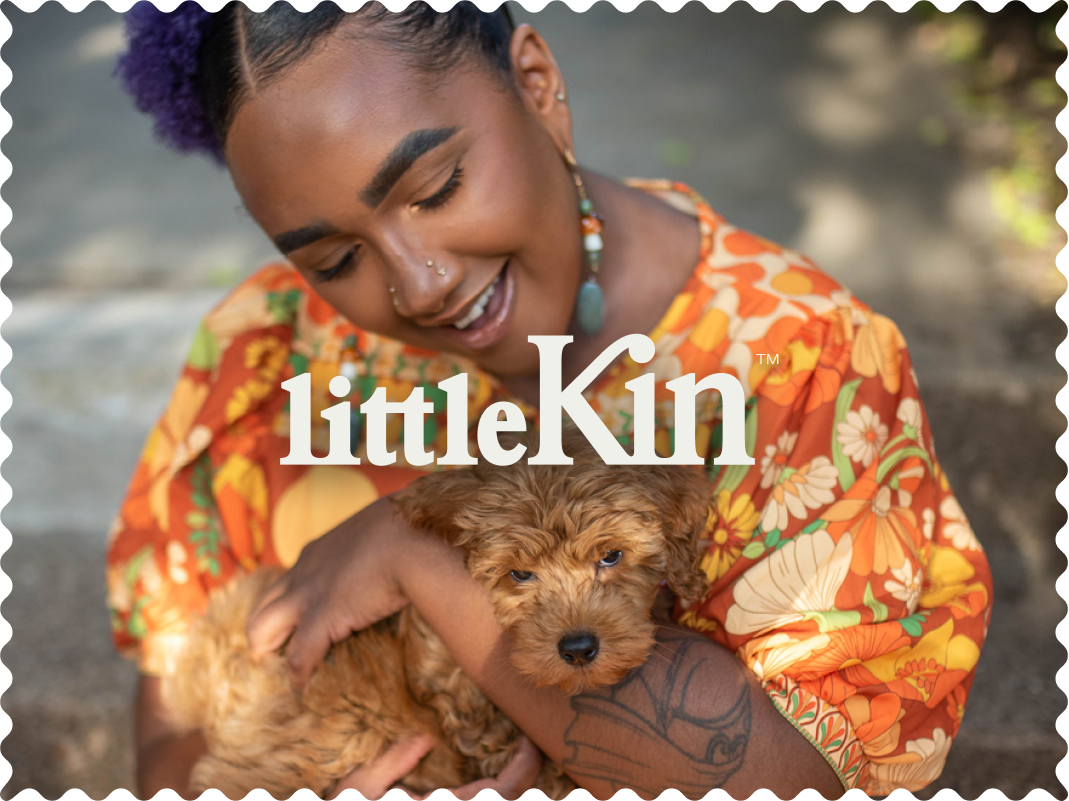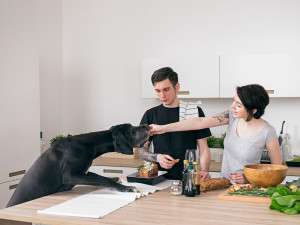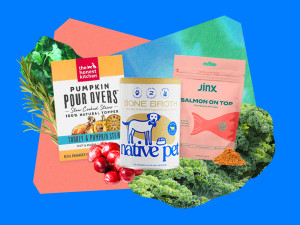Can Dogs Eat Pork? How to Make This Tasty Treat for Your Pup
There's a reason why it's not normally in dog food. Here’s how to make it safe for your pup.

Share Article
Pork is enjoyed by many people worldwide, but can dogs eat pork? It’s not uncommon for dogs to want to try any food their pet parents are eating, including pork. However, not everything we eat is safe for pets. So let’s look at the question of dogs eating pork more closely. We’ll explore if pork has nutritional benefits for your dog, if there are risks in feeding your dog pork, and the best way to prepare pork for your pup.
Can dogs eat pork?
The straightforward answer is “Yes.” Dogs can eat pork, but there’s more to it than that. If you feed your pup plain pork without any seasoning and bone, that’s fine. Pork is a good source of protein for dogs. However, if the pork is processed like sausages, ham, and bacon, you should keep it away from your dog. Those items are too high in salt and preservatives.
Nutritional benefits of feeding pork to your dog
Although risks come with feeding your dog sausage, ham, and bacon, pure pork has some advantages.
High-protein content
Protein is necessary for tissue repair, muscle growth, and overall dog health. Pork can help keep your dog’s diet well-balanced and filled with high-quality protein. Pork will also help maintain strong muscles that support your dog’s energy levels.

Vitamins and minerals
In addition to protein, pork is also an excellent source of other nutrients.
B vitamins (B1, B6, B12): These vitamins help brain function, nerve health, and energy metabolism.
Zinc: This element helps skin health and aids the immune system.
Iron: A necessary mineral for red blood-cell production, iron aids in oxygen transport.
Risks of feeding your dog pork
While there are benefits to feeding your dog pork, it may also come with some risks.
Additives
It is common for pork products to contain seasonings, preservatives, or sauces that can harm your dog. For example, giving your dog garlic, onion powder, and excessive salt can be toxic and cause health problems such as anemia or high blood pressure.
Toxic ingredients
We talked about ham and bacon being high in sodium, but they are also high in fat. Excessive fat intake increases the risk of pancreatitis in dogs.
Bacteria and parasites
You’ve no doubt heard that you shouldn’t eat raw or undercooked pork. The same is true for your dog. Raw or undercooked pork can contain parasites such as trichinella spiralis, which causes a disease called trichinosis. It can affect both humans and dogs. You can eliminate this risk with proper cooking.
Allergies
Food allergies are relatively common in dogs, and pork is a protein your dog could be allergic to. Symptoms include itching, GI disorders, or ear infections. If you introduce pork into your dog’s diet, do so gradually and monitor for any adverse reactions.
Why aren’t there any pork-based dog foods?
You are more likely to see chicken, beef, or fish in dog food than pork. Here are some reasons why.
The fat content of pork is higher.
Some cultures avoid pork.
Concerns over parasites in pork may have led to lower usage of it in pet foods.
Safe ways to cook pork for your dog
Is raw pork safe for dogs?
Raw pork is unsafe for dogs due to the risk of parasites and bacterial infections. Always cook pork thoroughly to an internal temperature of at least 145 degrees Fahrenheit (63 degrees Celsius) to kill harmful organisms.
Are pork bones safe for dogs?
Cooked pork bones can splinter. This can lead to choking, intestinal blockages, or internal injuries. If the bones are raw, they may carry bacteria. Select safer chew toys or dental chews.
How much pork can you feed a dog?
There’s no definite amount of pork you can feed to a dog. But think of pork as a treat, not a staple in your dog’s diet. When introducing any new food, start with a very small amount and monitor your dog’s reaction. Always remove excess fat and bone and avoid seasonings.
Signs your dog is having an allergic reaction to pork
Common symptoms that your dog may be having an allergic reaction to pork include:
Vomiting or diarrhea
Facial swelling
Swelling of the paws
Excessive scratching of skin or ears
If you notice any of these signs, stop feeding them pork and see your veterinarian.
Bottom line
Dogs can eat pork if it is free of added sodium and seasonings and is low in fat.
It must be cooked, and only a tiny amount should be given.
It should also be free of bones.
If your dog has never had pork, give them a small amount, increase it gradually, and monitor for any adverse reactions.
FAQs
Can dogs eat cooked pork?
Yes, as long as the pork is cooked and free of additives, excess salt, and bones. Avoid frying or using excessive oils and spices.
Which meat should dogs not eat?
Dogs should avoid processed meats such as bacon, ham, hot dogs, deli meats, raw fish, fatty cuts of beef, and any meat seasoned with garlic or onions.
What do I do if my dog ate pork?
If your dog ate plain, cooked pork, they should be fine if it was given in moderation. If they ate pork prepared with harmful seasonings or bones, monitor them for signs of distress, and if your dog appears ill, contact your veterinarian.
References
Buff, P. R., et al. “Natural Pet Food: A Review of Natural Diets and Their Impact on Canine and Feline Physiology.” Journal of Animal Science, vol. 92, no. 9, 1 Sept. 2014, pp. 3781–3791, academic.oup.com/jas/article/92/9/3781/4702209opens in new tab, https://doi.org/10.2527/jas.2014-7789opens in new tab.
Cole, Stephen D., et al. “Evaluation of Canine Raw Food Products for the Presence of Extended-Spectrum Beta-Lactamase- and Carbapenemase-Producing Bacteria of the Order Enterobacterales.” American Journal of Veterinary Research, vol. 83, no. 9, 1 Sept. 2022, https://doi.org/10.2460/ajvr.21.12.0205opens in new tab.
Solís, Doina, et al. “Microbiological Quality and Presence of Foodborne Pathogens in Raw and Extruded Canine Diets and Canine Fecal Samples.” Frontiers in Veterinary Science, vol. 9, 18 July 2022, https://doi.org/10.3389/fvets.2022.799710opens in new tab.

Dr. Shelby Neely, DVM
Dr. Shelby Neely is a freelance writer and veterinarian who graduated from the University of Pennsylvania School of Veterinary Medicine and has practiced veterinary medicine for 30 years, specializing in small animals. Her work has appeared in Allivet, AsktheCatDoctor, WhiskerDocs, Ask the Cat Doctor Radio, Ask the Cat Doctor TV, and numerous other websites, brochures, newsletters, newspapers, and ebooks. In her spare time, Dr. Neely likes to spend time with her three children, two grandchildren, three cats, two grand-cats, and five grand-dogs.
Related articles
Can Dogs Eat Raw Chicken?
They’re definitely curious about what you’re chopping over there on the cutting board...
![dog biting bubbles]()
Your Dog Will Lap Up These Literally Meat-Flavored Bubbles
The liquid bubbles pups are obsessed with.
![cat with a person eating a hot dog]()
Can Cats Eat Hot Dogs?
Find out of if your kitty can come to the barbecue this summer.
![pet parents making homemade dog food cheaper for black dog climbing on counter]()
Is Cooking Your Dog’s Food Worth it?
A nutritionist on dogs’ unique dietary needs, important ingredients, and other pro tips for home-cooked dog food.
![collage of dog food toppers on blue background]()
9 Food Toppers That Will Make Your Dog Actually Want to Eat Dinner
If your dog suffers from mealtime boredom, spice up their food bowl with one of these tasty toppers.







